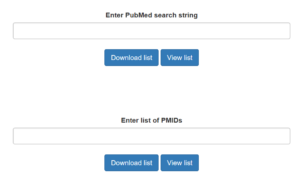Finding out who cites your body of work

One of the most common ways that universities and institution use to evaluate scientists is to solicit letters of recommendation. But who should they ask? Of course former mentors will write letters. To get a richer and broader picture, mentor letters are typically supplemented by letters from more “independent” scientists. Who can those be? Who is in a good position to evaluate the scientist?
How about people who cite your papers? Not just one paper, but people who have cited multiple papers of yours. They probably know your work fairly well, and find it valuable. They are in a good position to explain the importance and impact of your work, and they are not necessarily people you know or otherwise have a conflict of interest.
This seems like a good method to identify potential letter writers. But how do you figure out who cites your body of work? Many online bibliographic tools let you see who sites a particular paper, including PubMed and Google Scholar. But how can you consolidate these per-paper citations lists into one full list? You could search one-by-one and compile the results yourself, but that’s time consuming.
Fortunately, there’s a better way.
After I posted a request for such a tool:
I want a script (for @PubMedHealth and/or @Google Scholar): Input = publication list (e.g., the results from a PubMed search). Output = a list of authors who have cited those papers (and number of times, and which papers, etc.). We will pay a developer if needed. Please retweet.
— Labrigger (@Labrigger) March 11, 2018
Sihao Lu, a graduate student in Simon Schultz’ lab at Imperial College London, answered the call. He wrote a nice script that does this for you, using the PubMed database. He has made the code available and set up a web site where you can run your own queries. ** EDIT 2022-Dec-31: The old page doesn’t work anymore, this new one works now. Thanks, Sihao!
For the results, you can either download the CSV file (readable in Excel or Google Sheets, or pretty much anything really) or display the results in the browser window. The leftmost column is for author names, the next column is the number of times they’ve cited your papers (total citations, so if they cite paper A three times and paper B five times, that counts as a total of eight citations). The last two columns are lists of PubMed IDs (PMIDs). The third column is the list of YOUR papers that the author cited, and the rightmost column is the list of THEIR papers in which they cited your papers. Note that the lists of PMIDs are ordered the same, and duplicates are kept. So you can do further analysis if you like.
Try it out and let us know what you think!


Great tool! It would be nice to get the ‘author name’ ‘s linked with the list of that author’s publication in PubMed.
This app has been updated.
You can now make it return a list that excludes your co-authors.
https://flask-fetch-citation.herokuapp.com/